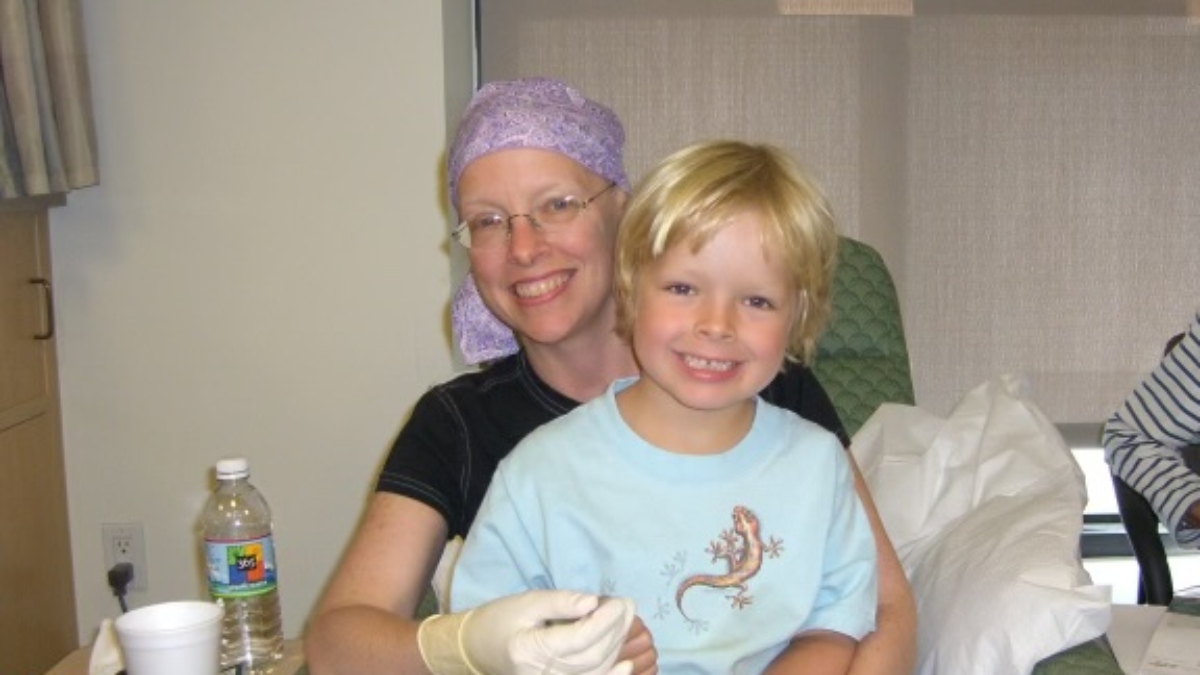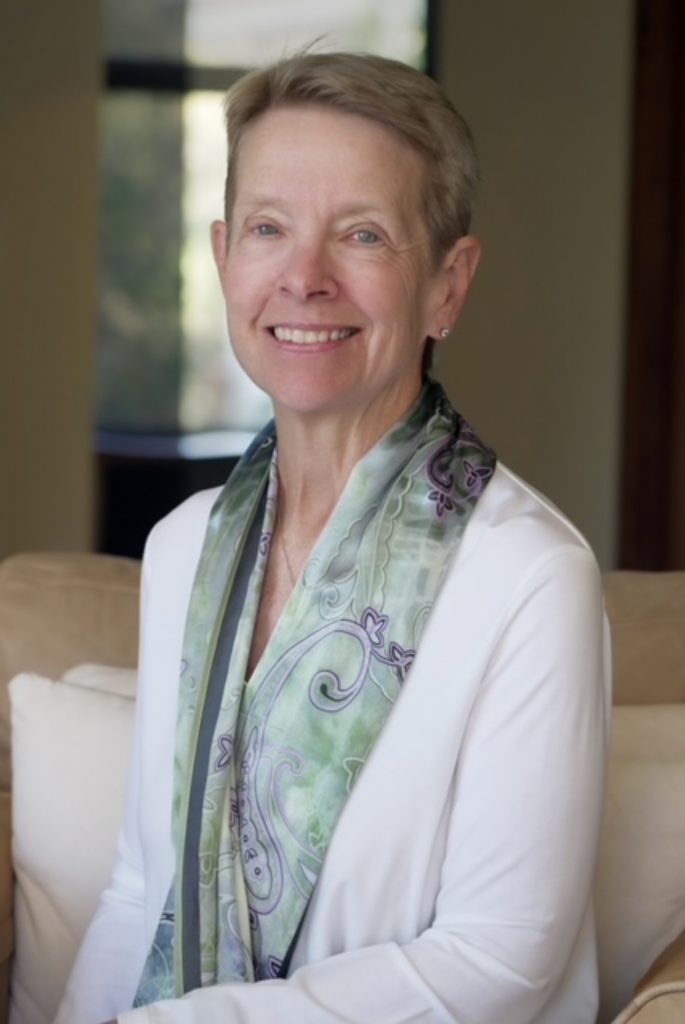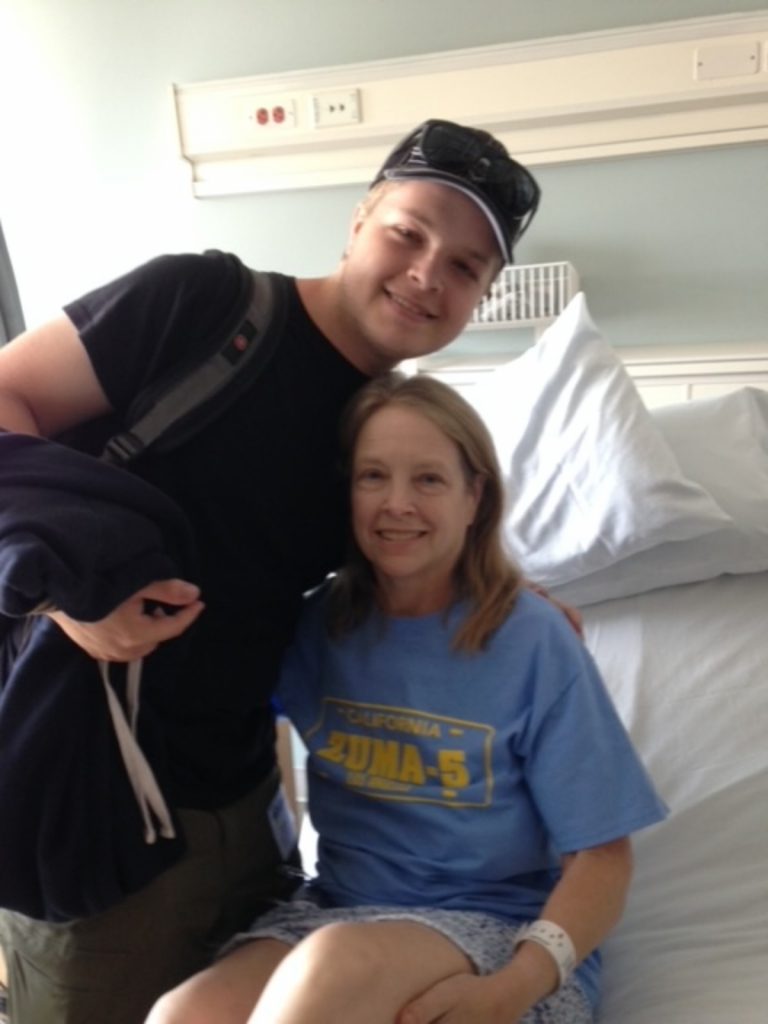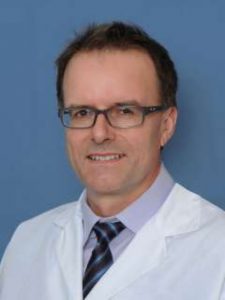CAR T-Cell Therapy, When All Else Fails
- Laurie Adami was 46 years old with a young son when she was diagnosed with stage 4 non-Hodgkin lymphoma.
- Six therapies had failed to treat her disease, and she was scared she wouldn’t survive for her child.
- Then in a clinical trial, Laurie received the revolutionary treatment CAR T-cell therapy, which re-engineers a patient’s own immune cells (T cells) to better fight cancer.
- Laurie received the brand name Yescarta (generic name axicabtagene ciloleucel), which is FDA-approved for adults with relapsed or refractory (did not respond to treatment) B-cell non-Hodgkin lymphoma and follicular lymphoma.
- Within days of Laurie's treatment, her tumors started to shrink. And within 30 days, they were "vanishing," she said.
- Dr. Sven de Vos said he was surprised at the time by her incredible response to CAR T-cell therapy, but now he understands that this groundbreaking and life-changing treatment can lead to a significant reduction of disease when other treatments have failed.
After six failed treatments, Laurie couldn’t bear the thought that she wouldn’t survive.

Laurie Adami’s Lymphoma Journey
Laurie’s cancer story began like so many others: she had persistent symptoms that went undiagnosed. It took two years for her to receive a proper diagnosis.She began experiencing excruciating sinus infections, and doctors prescribed antibiotics. A few months would go by and it would seem like the infection was gone, only to have it come roaring back.
She also had a swollen lymph node in her neck and felt something in her abdomen. Laurie’s fatigue was overwhelming.
“Frustrated by the care I was receiving, I took to researching my symptoms online. I came up with non-Hodgkin Lymphoma. When I suggested this to my doctor, he rolled his eyes in my husband’s direction and blew me off,” Laurie said.
She said her doctor told her the bump in her stomach was a hernia.
“Probably from giving birth to your son,” was his explanation, she said.
The lump in her neck? “Well, it’s from your sinus infections,” he insisted, she said.
The constant infections? “Maybe you have allergies,” Laurie recalled him saying.
And the fatigue? “Well, you’re the president of a company, traveling every month, taking care of a little kid at home and running a household. I’m tired just thinking about your life!” she said he joked.
Laurie didn’t think it was funny.

Finally, a Diagnosis
Two years after her first visit with a doctor, in 2006, Laurie was finally diagnosed with stage 4 non-Hodgkin lymphoma, with only a 50% chance of surviving two years.
“When it comes to cancer, you think it’s never going to happen to you and when it is you, you may have no idea what to do next,” she remembers thinking.
Laurie went from being president of a software company to suddenly looking at her future as potentially very short.
“When I heard that I might only be alive for a couple of years, I completely lost it,” Laurie said.
She recalled the doctor being dismissive of her emotional reaction to potentially dying of cancer, telling her that “two years is a really long time.”
“If this was his expectation for my cancer diagnosis, I wanted nothing to do with him,” she said.
So Laurie went to find a doctor who would help her survive much longer.
View this post on Instagram
What Is Non-Hodgkin Lymphoma?
Non-Hodgkin lymphoma (NHL) is a type of blood cancer. More specifically, it’s a cancer of the immune system that affects infection-fighting cells called lymphocytes.
Lymphoma starts when lymphocytes develop a genetic mutation that makes them multiply much faster than usual. The quickly multiplying lymphocytes start to collect and build up in your lymph nodes, the small glands in your neck, armpits, and other parts of your body.
From there, the disease is divided into a number of different categories, such as Hodgkin lymphoma and non-Hodgkin lymphoma (the more common type).
Laurie was diagnosed with follicular NHL, which develops when the body makes abnormal B-cell lymphocytes.
WATCH: What Kind of Lymphoma Do You Have?
NHL can begin anywhere in the body where lymph tissue is found. The major sites are:
- Lymph nodes: Lymph nodes are bean-sized collections of lymphocytes and other immune system cells throughout the body, including inside the chest, abdomen, and pelvis. They are connected by a system of lymphatic vessels.
- Spleen: The spleen is an organ under the lower ribs on the left side of the body. The spleen makes lymphocytes and other immune system cells. It also stores healthy blood cells and filters out damaged blood cells, bacteria, and cell waste.
- Bone marrow: The bone marrow is the spongy tissue inside most bones. This is where new blood cells (including some lymphocytes) are made.
- Thymus: The thymus is a small organ behind the upper part of the breastbone and in front of the heart. It's important in the development of T-cell lymphocytes.
- Adenoids and tonsils: These are collections of lymph tissue in the back of the throat. They help make antibodies against germs that are breathed in or swallowed.
- Digestive tract: The stomach, intestines, and many other organs also have lymph tissue.
Laurie Begins Treatment for NHL
Laurie was diagnosed with NHL in 2006. Back then, there was only one approach to treating her type of non-Hodgkin lymphoma: R-CHOP, "a combination of three chemotherapy drugs given along with a monoclonal antibody (protein that helps the immune system) and a steroid," according to City of Hope.
Heavy-duty stuff.

Reactions during the infusions can include a skin rash, itching, swelling of the lips, face or throat, breathing difficulties, fever and chills.
The treatment was so grueling, Laurie had to take leave from work.
However, there was soon good news. After three cycles of the difficult treatment, she had a scan that showed her cancer was completely gone.
Still, since the protocol was for six treatments, she endured three more rounds before the medical team declared she was in complete remission.
“Merrily, I went back to work. But three months later I had a follow-up scan. It revealed that the cancer had returned in my lungs,” Laurie recalls.
Laurie’s Cancer Comes Back Again and Again
At this point, Laurie wanted another opinion. She went to a different health institution and enrolled in a clinical trial, her second treatment.
It made her stable for a year, but eventually, her cancer returned again.
This was Laurie’s pattern.
When her third and fourth treatments failed too, she said three different medical facilities told her there was nothing left to do.
“The doctors had basically given up on me,” she said.
But she wasn’t going to give up on herself.
WATCH: Waiting for Non-Hodgkin Lymphoma to Relapse
That’s when she found a clinical trial that connected her with the doctor who turned out to be just who she needed.
In 2011 she met Dr. Sven de Vos, a hematologist/oncologist in Santa Monica, California, who is specially trained in treating blood disorders. He is also a professor and director of the UCLA Lymphoma Program, Division of Hematology and Oncology in David Geffen School of Medicine at UCLA.
She sent him an email describing her desperate situation.
An hour later her phone was ringing. It was Dr. de Vos.
“‘I read your email and I have a drug I think will work really well for you,'” Laurie remembered him saying.
Laurie grabbed her purse and drove right over.
View this post on Instagram
“I knew I had only one slot left and that needed to be secured for her right away if we wanted to give her this opportunity,” Dr. de Vos told SurvivorNet.
Dr. de Vos explained how he saw Laurie’s situation: “Laurie had already received various intense regimens that were followed by unusually rapid relapses. For example, within two months of her most recent regimen, which included significant chemotherapies and radioimmunotherapy, she had clinical and biopsy-proven relapsed disease.”
In this clinical trial, Laurie’s medication was a small-molecule inhibitor, a type of targeted therapy. The pill gave Laurie another five years, but, once again, the cancer came back.
Now she was on to her sixth treatment. And it didn’t work either.
“My cancer was coming back and really getting large,” Laurie said. “I was in pretty bad shape.”
In 2018, when Laurie had about 8 pounds of tumors raging in her body, CAR T-cell therapy finally entered the picture.

De Vos was now the principal investigator of another clinical trial, the ZUMA-5 CAR T-cell Phase 2 multicenter study. They were testing the efficacy and safety of CAR T-cell therapy in patients with slow-growing non-Hodgkin lymphoma that has come back after previous treatment (relapsed) or has not responded to other treatment (refractory).
“I was at a high risk for the CAR T treatment, but I also had no other viable options,” Laurie said.
Within days of Laurie’s treatment, her tumors started to shrink. And within 30 days, they were “vanishing,” she said.
“I was clean. My cancer was gone,” Laurie said.
She was shocked. And so was Dr. de Vos.
What Is Cart T-Cell Therapy?
CAR T-cell therapy is revolutionizing the way doctors treat certain blood cancers. And it’s giving patients new hope where they thought none existed.
“I’ve hit on a couple things in my career that were exciting and hard to believe, and this was one of them,” Dr. Stephen Schuster, director of the Abramson Cancer Center’s lymphoma program, told SurvivorNet in a previous conversation.
“Not only did it work, but with a single treatment these patients were not relapsing.”
Chimeric antigen receptor (CAR) T-cell therapy is one of the most promising treatments for blood cancers. It’s a type of cancer immunotherapy treatment that uses a patient’s own immune cells (T cells) to help fight cancer.
Those T cells are genetically modified in a lab, multiplied into the millions, and returned to you. Once inside your body, the newly modified cells are able to better recognize and eliminate your cancer.
WATCH: Why CAR T-Cell Therapy Is So Exciting
Currently, CART-T therapy is FDA-approved to treat several types of hematological malignancies, including:
- B-cell acute lymphoblastic leukemia (ALL)
- B-cell non-Hodgkin lymphoma
- Follicular lymphoma (like Laurie had)
- Mantle cell lymphoma (MCL)
- Multiple myeloma (like what legendary broadcaster Tom Brokaw has)
Laurie received the brand name Yescarta (generic name axicabtagene ciloleucel), which is FDA-approved for adults with relapsed or refractory (did not respond to treatment) B-cell non-Hodgkin lymphoma and follicular lymphoma.
Other FDA-approved drugs include Tecartus (brexucabtagene autoleucel), Breyanzi (lisocabtagene maraleucel), Abecma (idecabtagene vicleucel), Carvykti (ciltacabtagene autoleucel) and Kymriah (tisagenlecleucel).
There are also dozens of trials taking place for solid tumor cancers as we as autoimmune diseases such as Lupus.
Receiving CAR T-cell therapy usually takes a few weeks. The steps, according to Penn Medicine, include:
- Collecting the T-Cells. Technicians draw blood from a vein in the patient’s arm. The blood flows through a tube into a machine that removes T cells. The machine is called an apheresis. Once the T cells are removed, the machine returns the rest of the blood back into the patient’s body through a different tube.
- Re-engineering the T Cells. Scientists in a lab re-engineer the T cells by adding a manufactured CAR. Next, the scientists wait while the CAR T cells multiply and grow.
- Giving the CAR T Cells. When the lab has enough CAR T cells, they are injected back into the patient’s arm. Chemotherapy may be recommended for the patient before the infusion to help with the treatment’s effectiveness.
The process can take place in an outpatient infusion center or in the hospital. Patients are closely monitored and followed up with so medical professionals can watch for any adverse side effects or reactions.
Although the CAR T-cell therapy process can take several weeks, it is typically administered only once.
If you are going to be receiving CART T-cell treatments, you and your caregiver and your healthcare team will make a plan that’s unique to you and make adjustments as needed along the way.
While CAR T-cell therapy is a game-changer, it still doesn't work for everybody all the time. Some patients will go into complete remission, while others may still see their disease return.
Side Effects of CAR T-Cell Therapy
Laurie’s CAR T-cell therapy resulted in significant side effects, Dr. de Vos told SurvivorNet. That’s because the side effects of CAR T-cells are also related to the tumor burden (number of tumors) the CAR T-cells encounter, he explained.
In other words, the greater the tumors, the greater CAR T-cell response, and the more potential for side effects.
Common side effects of CAR T-cell therapy include:
- Weakness
- Chills
- Fever
- Fatigue
- Muscle or joint pain
- Nausea, vomiting or diarrhea
- Rapid heartbeat
- Low blood pressure
- Significant loss of appetite
The treatment may also cause nervous system symptoms like confusion, tremors or shaking, trouble speaking and loss of balance.
When it comes to the side effects Laurie experienced while receiving CAR T-cell therapy, that was back in 2018. She likes to highlight that doctors have learned much more about how to manage side effects for CAR T-cell patients now. Today they have plenty of methods to help patients deal with possible side effects.
“We try to keep the tumor burden going into CAR T-cell treatment small,” de Vos said. “Enough to activate CAR T-cells and small enough to avoid massive over-activation.”
“We also learned that it is better to suppress over-reacting CAR T-cells earlier and not later. That way only a little immunosuppression is needed as compared to massive amounts of steroids,” De Vos added.
But it’s important to note that CAR T-cell therapy can still lead to serious side effects, including the risk of infections or bleeding and allergic reactions.
Dr. Siddhartha Ganguly, director of the Lymphoma/Myeloma Program at the University of Kansas, explained another unintended consequence of CAR T-cell therapy.
“I usually give the analogy of the Pac-Man going after the cancer cells. When they are in contact with the cancer cells, they release chemicals to kill those cancer cells,” he told SurvivorNet in a previous conversation.
While those chemicals, called cytokines, are very effective at targeting cancer, they can also cause side effects.
When released into the body, cytokines can cause symptoms and reactions in various organs and systems. One serious condition called cytokine release syndrome (CRS) can then develop.
About one-quarter or more of people who go on CAR T-cell therapy will have some form of CRS. The good news is, very serious reactions are rare. And few people actually die from CRS.
Doctors are studying methods to prevent CRS, in the meantime taking great precaution to monitor patients. In very serious cases, there are medications that can slow the flow of cytokines and relieve symptoms.
WATCH: The Promises and Risks of CAR T-Cell Therapy
Laurie’s Unbelievable Response to CAR T-cell Therapy
“I feel so fortunate that CART -T came along. It saved my life,” Laurie said.
Survivornet asked Dr. de Vos if he was surprised by Laurie’s positive response to CAR T-cell therapy.
“At the time, Yes,” Dr. de Vos said. “But in hindsight, No, not really.”
De Vos explains: “The ZUMA-5 trial which Laurie was a participant, evaluated CAR T cells in low-grade non-Hodgkin lymphoma, and it led to excellent results. 92% of participants had an overall response (complete or significant tumor reduction) and 74% had a complete response (disappearance of all cancer signs).
“We knew that the activity of CAR T cells is related to the tumor burden the CAR T-cells encounter in the body. Laurie had a very high tumor burden and that resulted in a dramatic activation of her CAR T cells.”
“These battle-proven lymphoma cells turned out to be no match for a focused attack of the patient’s own immune cells,” de Vos added.
When it comes to treating the kind of lymphoma Laurie had (follicular lymphoma) – with CAR T-cell therapy, de Vos has said the outcomes are “the best results of any disease treated with CAR T cells so far.”
View this post on Instagram
So Is Laurie… Cured?
CAR T-cell therapy worked for Laurie like no other treatment was able to work for her. The incredible reduction of disease she experienced is nothing short of remarkable.
“I consider her cured,” says Dr. de Vos said.
However, he stressed that, at least scientifically, he can’t prove it yet.
“It’s only been three years, and we need more time to look back and to be able to say if we really cured patients. But clearly, Laruie Adami never had a complete remission that lasted this long.”
Now, Laurie is making sure that as many patients (and doctors) as possible know about this life-changing (and potentially life-saving) treatment.
“I’ve made it my mission to spread the word. There are still patients unaware of this therapy — and unbelievably there are also oncologists who may not be aware of it,” Laurie said.
She currently serves as a legislative advocate for the Leukemia & Lymphoma Society.
“That’s why I’m doing all I can to educate people. To spread the word, so that many more lives can be saved.”
Brave Lymphoma Survivors
The Future of Blood Cancer Treatment
Dr. de Vos and his team are now looking at activating a patient’s T cells by using bi-specific antibodies. It would mean giving an infusion or injection of antibodies that bind to the lymphoma cells and T cells to activate the T cells right there in the body, instead of in a lab.
There would be no need to take them out, wait and then give them back.
According to Dr. de Vos, “This type of treatment has so far been shown to be very effective.”
He adds: “What we are most excited about is to use these treatments much earlier, even as the first line of therapy,” says de Vos. “Why expose the patient's body to toxic chemo if you could redirect a perfectly fit immune system to do the job instead? That’s the direction and future of lymphoma therapy.”
Learn more about SurvivorNet's rigorous medical review process.

